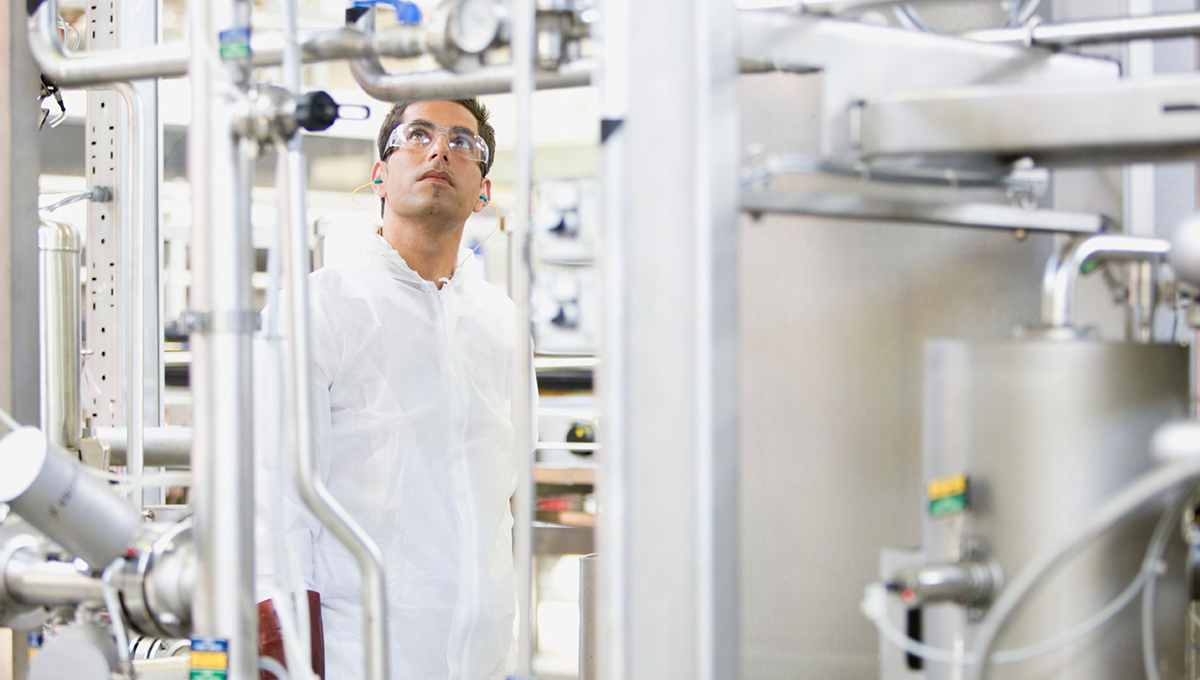Has the Chemical Industry’s Embrace of Innovation Finally Arrived?
Sector pivoting toward new models and technologies to balance climate goals and long-term profitability.
Even as the cadence toward adopting sustainability goals among broad swaths of industry was quickening over the past decade or more, one sector continued to march at its own pace. Stymied by a perfect storm of challenges – the rise in global energy prices and inflation combined with ever-tightening margins – chemical companies largely watched from the sidelines as other industries embraced ESG goals, moving aggressively through a commitment to innovation and a reordering of corporate priorities.

But today, all of that is changing. The stabilisation of world oil prices and increasing revenue, especially in Chinese markets, have given rise within a wide cross-section of the chemical sector to a renewed embrace of technology, an exploration of chemistry-born solutions, an adoption of forward-leaning models and a movement toward levels of innovation that only a few years ago seemed unimaginable. Breaking out of a long-held complacency that is often part and parcel of mature industries, companies are exploring progressive strategies led by a renewed commitment to R&D and a forward-leaning embrace of new models. In fact, innovation is becoming an enabler to balance long-term profitability and climate goals.
Across the globe, chemical companies large and small are putting a priority on innovation – or what we might simply call the commercialisation of good ideas, especially when it comes to 02 sustainability. In India, Tata Chemicals’ embrace of next-generation science and green chemistries is propelling itself in new directions. Britain’s Johnson Matthey is developing fuel and bioplastics through natural feedstocks. The Erca Group in Italy is upcycling waste into circular highperforming chemical products for the textile industry. The German manufacturer Evonik is using Glycolipid Biosurfactants to make cleaning products. And in the U.S., Dow Chemicals is leaning into the use of recyclable materials for tires that carry a lower carbon footprint.
What’s clear is that, irrespective of a company’s size, there has been a mindset shift, leading companies to conclude that progress can be made on the sustainability front, even as profits move upward. Ironically perhaps, these kinds of greenleaning contributions, which hold the promise of making a discernible impact on sustainability, can herald the next glory era for the chemical industry. Consider the following effects of the industry’s embrace of innovations that are moving the levers on sustainability.
Value creation through innovation
First, the industrialisation of new ways to produce goods is boosting job creation, particularly within other industries. The ancillary impact up and down the line is spawning the development of new products whose manufacture requires a broader array of skills, a larger labour force to meet rising demand and a reinvigorated sense of entrepreneurship within related fields.
Next, chemical companies are not immune to growing societal expectations around sustainability. Unlike in years past, scientists toiling among chemical manufacturers today are being driven by a productive spirit, inspired at knowing that their pioneering contributions are moving the sustainability needle. Rather than bear the label of industrial loathing, they are now taking pride in how innovations are reshaping long-held attitudes about the chemical industry’s place in helping to achieve global climate goals.
In much the same way, this rehabilitated pride of purpose across the industry is not lost on young scientists, those who have largely eschewed chemical careers in the past to avoid the stigma associated with a “dirty” industry whose role has not been viewed in a positive light. These days, however, as chemistry-born innovation continues to make strides in enhancing sustainability, a new generation of scientists are considering chemistry as a means for making the kinds of contributions through their profession that make them feel less like a part of the problem and more like a part of the solution. The net result is more bright minds entering the field.
Finally, this focus on innovation is not exclusively driven by ESG goals or a greater sense of altruism toward the role of the industry. The fact is innovative solutions provide a bottom-line opportunity to grow margins within a mature market that for years has become commodity driven. Innovation is having a top-to-bottom impact on the whole value chain where new ideas, new processes and new skill sets are creating greater efficiencies and new lines of business opportunity. A move toward digitisation is one such example which is allowing companies to operate more efficiently, thus reducing the company’s carbon footprint, improving production capacity and enhancing brand reputation.

The Path Forward
The full scope of this progress – transformative in ways that redefine a longmaligned industry as a motivated ally in the trenches aligned against climate change – is exciting to contemplate.
But it is not without its risks and hurdles, especially for companies whose cultures, behaviour and structures have traditionally not been conducive to innovative thinking. To determine what’s driving this innovation, it’s instructive to examine the ways in which companies are navigating the oftenbumpy roads that come with adopting new approaches to their fundamental businesses.
Consider the following four perspectives that amplify how the industry can avoid potential pitfalls and continue to move forward productively.

1. Focus innovation efforts.
Innovation is far less impactful when it is happening independently within discrete silos. A sustainability mindset must be integrated comprehensively throughout the value chain – from the C-suite through production lines. We have seen uncontrolled innovation become a distraction, and even worse, innovation that is not aligned with corporate objectives can smother growth. Articulate a clear objective when it comes to innovation and be disciplined in focusing efforts exclusively on ways to attain that goal. Concurrent to those efforts is developing improvements within existing operations that will contribute to achieving productive end results.
As companies take on these challenges, it’s helpful to understand what is driving so much of the innovation. While enhanced revenues are helping provide the resources to make the pivot possible, the wind behind it is coming from a variety of directions, market demand among them. Not only do chemical companies themselves have their own ESG goals, but so do their customers who look to manufacturers up and down the supply chain to help them attain them. Chemical companies are positioned rather upstream in the value chain. Consequently, they fall within Scope 3 carbon reduction targets for their customers who make up a significant share of the value chain downstream. This raises expectations that chemical companies should be putting a priority on developing more sustainable products through reduced material use, emissions and waste. In addition to the technology-driven approaches around renewables and decarbonisation, effective holistic approaches more frequently embrace culture, mindsets and behaviours. This holistic approach creates a cultural shift in internal Operational Excellence teams and makes a profound difference.
Chambroad Petrochemicals, a dss+ client, in eastern China reflects this new reality. The company is charging forward on multiple fronts, putting innovation front and center. The privately run enterprise has built 13 innovation centers across the country and is integrating technological resources from dozens of universities. It has turned its refining factories into demonstration bases for the industrial application of new technologies.

2. Manage risks.
Risks are inherent with change, and you should anticipate the risks that will arise from your innovation outputs – i.e. new processes, new technologies, new assets – and innovation mandates from government. While anticipating those risks is the first step, more important is managing them in a way that reduces or even eliminates these risk factors, whether they are likely to impact operations, productivity, margins and even brand reputation. As with above, risk assessment should be undertaken in a cumulative way – the sum total of a comprehensive list of anticipated risks.
In addition to market forces, we cannot overlook the overlaying government mandates that are prescribing bold climate change targets in various parts of the world. With these mandates and requirements to comply comes the need to manage risk. The European Green Deal, for example, singles out chemical companies to achieve substantial reductions. The EGD identifies 12,000 chemicals that need to be substituted or reformulated – products that represent 12 percent of the European chemical sector’s annual sales1. In the Pacific, some governments have announced net-zero climate targets by 2050 (Japan and South Korea) and 2060 (China) and ESG related regulations are being established and evolve. As a result, as of 2024, 50,000 companies in the Asia-Pacific region are subject to mandatory sustainability reporting requirements2.
The Chinese government also has implemented new requirements that call on domestic businesses to become self-sufficient, a condition that has chemical companies pushing R&D downstream where its potential impact can more broadly flourish and where it can focus on value-added products, including specialty chemicals. One consequence of this mandate is the fact that Chinese chemical companies are innovating more quickly than anywhere in the world. Their leadership in accelerating the development of more effective solar panels and lithium batteries are but two examples.

3. Create an iterative plan.
Notwithstanding a company’s experience and acumen, it’s rare that a plan to harness innovation gets it exactly right the first time. We help our clients understand that, while perfection may be elusive on day one, it’s critical that companies undertake a process that is flexible and iterative. Operational excellence most often is achieved by making adjustments to initial thinking. Too often, we see companies approach the implementation of new ideas by approaching it through many plans that may overlap and even clash. We have found that an integrated approach – one single plan that evolves over time – is more effective.
That emphasis on flexibility, on introducing innovation through an iterative process, or integrating elements from across the value chain from the onset is what paves the way for ultimate success. While the embrace of innovation among chemical companies is far afield, much of the industry is coalescing around these essential factors that are less chemistry-centric and more focused on processes – processes that put an emphasis on sustainability and minimising waste and pollution.
The growing adoption of circular models is one example. Processes like chemical “leasing” seek to create a more efficient use of chemicals in the production process, one that redefines the relationship between user and supplier. Advanced recycling technologies that repurpose plastic is another circular model strategy, one being employed by ExxonMobil, among others.
Governments are creating incentives for this kind of recycling and a move toward more responsible production and self-sufficiency. Thanks to new petrochemical complexes, full self-sufficiency in the Chinese market is expected as early as next year. Companies within and outside China are phasing out businesses that have reached their limits, having exhausted improvements in Scopes 1 and 2. With the focus now on Scope 3, companies are making adjustments to transition to new ventures, such as materials for batteries and eco-friendly plastics.
One area that requires a top-to-bottom commitment, that has been rolled out in flexible, iterative ways is the growing commitment to carbon capture. The process involves the capture of carbon from industrial emissions, treating it and transporting it to a long-term storage location, such as a geological formation – a process that requires a strong integrated approach. Chemical companies are rolling out next-generation carbon capture systems, which are based on membranes, cryogenics and solid sorbents. An article in Chemical & Engineering News estimates that “carbon capture will need to provide up to 15%—5.6 billion metric tons per year by 2050—of the global CO2 reductions needed to avoid the worst effects of climate change3. In 2021, more than 100 new carbon capture projects were announced, far more than previous years. In fact, the plans toward carbon capture has been so comprehensive that it is becoming an essential part of the industry’s social license to operate.

4. Collaborate with industry, academia and external experts.
Adopting innovation in ways that achieve operational excellence is far from intuitive. Understandably, most companies do not have the internal knowledge to put all the pieces together in an integrated fashion, which is why many businesses rely on outside expertise. By providing seasoned, proven guidance, external experts can help facilitate the structural, procedural and cultural changes that will be necessary to ensure that innovative strategies are taking root in the most effective way possible.
Consider the trend toward value chain collaboration as an example.
Companies actively pursuing the kind of circular business innovation are integrating it more broadly into their growth strategies. Chemical companies are now putting more of a priority on sourcing from local vendors, a fundamental element of sustainability and a critical component of achieving a circular economy. The industry is moving toward driving new revenue streams by committing to new technologies and products and increasing its share of alternative feedstocks. Sustainable feedstock like biomass, as well as the adoption of humic matter from biomass, reduces reliance on fossil fuels. Similarly, the adoption of “green chemistry” principles as part of a company’s R&D process and direction reflects the comprehensive nature of the industry’s emerging philosophy.
Wanhua Chemical, a dss+ client, is making innovation a priority of its market position, backing it up with a deep commitment to R&D. The company has applied for more than 6,400 invention patents in China and abroad and has received numerous awards and accolades for its integration of new technologies into its products and operations. In 2022, it signed strategic cooperation agreements with three partners, including Peking University, partnerships that are leveraging their respective talents and technological platforms and fostering collaboration in developing new energy and functional materials. By all accounts, Wanhua is living its brand promise of “advancing chemistry, transforming lives.”
In the Netherlands, the Elsevier Foundation is working to incentivise the application of chemistry toward finding climate change solutions across the globe. For the past eight years, the organisation has conducted the Elsevier Foundation Chemistry for Climate Action Challenge, a competition that annually elicits pioneering applications of chemistry with an eye toward sustainability.
A New Era
- https://eeb.org/the-great-detox-largest-ever-ban-of-toxic-chemicals-announced-by-eu/
- https://www.unescap.org/blog/accelerating-sustainability-reporting-asia-and-pacific
- https://cen.acs.org/policy/CENs-World-Chemical-Outlook-2022/100/i2#:~:text=According%20to%20Emma%20Martin%2DRoberts,are%20starting%20to%20pour%20in